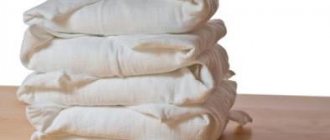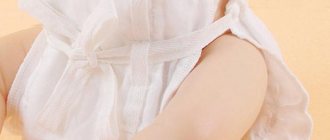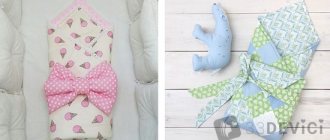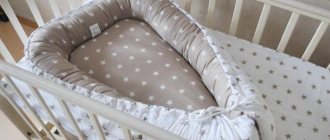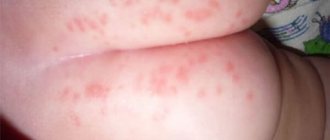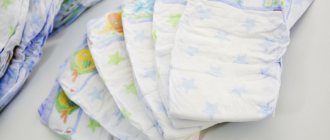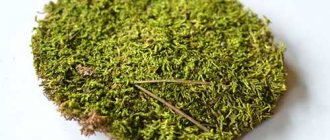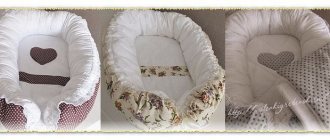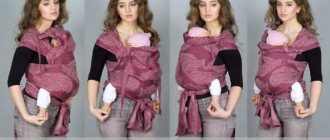How to make diapers from gauze with your own hands
In the first months after birth, a baby makes an average of about 18 bowel movements per day. Your baby's sensitive skin requires special care during this period.
Previously, diapers were used for these purposes, which not only warmed the child, but also absorbed excess moisture and baby feces. However, diapers must be constantly changed, washed and ironed, which takes a lot of time and effort.
The advent of reusable diapers has made caring for a newborn much easier, but their cost leads to large expenses that not all parents can afford.
Homemade diapers will help solve the problem of maintaining the family budget when a child is born. One of the most suitable materials for their manufacture is gauze.
Types of homemade diapers
There are two general types of diapers available for DIY:
- Disposable products.
They are folded in the shape of a triangle or square from soft fabrics, and then such a diaper is wrapped in a certain way on the child’s body. Disposable diapers are the simplest and most affordable to create with your own hands, but they must be constantly changed, washed and ironed. Gauze diapers are very simple - Reusable products.
They are a diaper sewn from natural fabrics with a special pocket made of oilcloth and a replaceable moisture-absorbing insert. Such a product can withstand several cycles of child bowel movements without the need for immediate replacement. Making a reusable baby diaper will require more time and materials, but such products are more practical and easy to use. Diaper with removable insert
Special requirements are imposed on the material characteristics of homemade products intended to maintain hygiene and preserve the health of a child’s skin:
- absence of components that can cause allergies and various dermatitis;
- the fabric should be durable, but soft enough so as not to rub the baby’s delicate skin;
- the diaper material should absorb moisture well, promote its removal and evaporation;
- The breathability of the material should allow the child’s skin to breathe.
Gauze diapers fully meet these requirements and have a number of advantages.
Advantages and disadvantages of gauze diapers
Gauze is a very cheap and accessible material
The following advantages can be cited in favor of choosing gauze as a material for homemade diapers:
- Economical. One standard package of gauze is enough for 20 homemade diapers.
- Environmental safety, absence of harmful substances and allergens in its composition.
- Easy fabric processing, allowing you to create diapers of the required shape and size
- Softness of the fabric.
- Air permeability, which helps to ventilate the skin and prevents diaper rash.
- All feces are quickly absorbed into the fabric, keeping the baby's body clean.
- Gauze diapers, unlike standard diapers, are not addictive and allow you to quickly potty train your child.
The advantages of baby gauze diapers are obvious, but you must also remember their disadvantages:
- due to the baby’s frequent bowel movements in the first months after birth, disposable gauze diapers must be constantly changed;
- untimely change of a wet gauze diaper leads to various rashes and skin irritations;
- A reusable gauze diaper does not last long; when walking with your child or, for example, going to the pediatrician, you should stock up on spare items.
If you need to travel with your baby, you can use standard reusable diapers. This will cost much less than the constant use of such products.
Shape options for disposable gauze diapers
Gauze blanks for making disposable baby diapers do not require special processing. It is enough just to cut pieces of clean fabric of the required sizes and overcast their edges. Then you should correctly fold and wrap the gauze on the child’s body so that it does not bunch up or curl for a long time.
You can fold a gauze diaper in one of three traditional ways:
- Kerchief.
For this option, you will need a piece measuring 180x90 cm. It is first folded in half, and then diagonally to form a triangular scarf. The child is placed on the center of the triangle, its lower end is passed between the legs, and the other two edges are wrapped around the baby on the sides and tied together with the lower corner of the scarf on the tummy. To secure this design, you can use braid or a belt made of soft, natural fabric. Gauze diaper "Klondike" - Rectangle.
This method requires a piece of gauze 100x60 cm, which must be folded lengthwise several times to ultimately form a multi-layer rectangle measuring 60x20 cm. One of its narrow edges should be tucked in. The girl is laid on the cloth so that the tucked, sealed end is under her back. The boy must be positioned so that this edge is in front of him. The bottom edge is then folded between the baby's legs onto his stomach. This diaper is secured with a belt or baby pants worn on top. Gauze diaper “Rectangle” - Hungarian version.
Take a square piece of gauze fabric with sides from 50 to 100 cm in length. The fabric is folded in half, then it must be folded again in the middle, but on the reverse side. The upper corner is folded back, as with a scarf, the gauze is turned down and the free edge is folded several times. As a result, there should be a compaction in the middle, on which the child is then laid. The bottom edge is pulled between the legs and the sides are folded over the top. The resulting diaper is tied with a belt. Gauze diaper "Hungarian"
It should be remembered that a homemade diaper should be comfortable for the baby, not rub his skin and not put too much pressure on the body. First you need to practice folding gauze fabric into a diaper and choose the most convenient method for yourself.
Sewing reusable gauze diapers
To create reusable gauze diapers, you will need special patterns, since such products require additional elements - a pocket and an insert.
The pocket should be made of waterproof material. To do this, you can use oilcloth or waterproof material. Inserts, on the contrary, should absorb liquids well. For this purpose, you can use fleece, bamboo or gauze fabric.
To prevent the material from coming apart later due to exposure to moisture, it must be folded in several layers and stitched along the edges. In this case, you should constantly check and periodically change wet liners. On average, about 12 such sets may be needed per day.
You can reduce their number by using a piece of terry towel sewn inside a gauze insert.
To create patterns, use thick paper or fabric; the blanks must correspond to the size of the baby. The inserts can be sewn on or secured using attached snaps. The diaper will stick to the baby more tightly if you sew buttons or Velcro on the sides of the product for fastening.
Caring for homemade gauze diapers
Gauze diapers are extremely easy to care for
In order for homemade gauze diapers to last longer and not harm the child’s health, you should adhere to the following rules for caring for the products:
- The set of disposable diapers and reusable diaper inserts must be updated periodically. It is advisable to completely replace them with new products every 2 months.
- Gauze diapers should only be washed by hand, using detergents intended for children's clothes. You can use pre-boiling gauze, appropriate powders, gels, baby and laundry soap.
- After washing and drying items, they must be ironed, which will not only soften the fabric, but also further disinfect it.
- When using homemade gauze diapers, you can use various powders and creams to prevent irritation and allergies.
Gauze diapers must be changed promptly and the baby's skin must be carefully examined. If any rashes are detected and such a reaction occurs again, you should discard the selected diaper material. It is necessary to change it to a new product or choose another option for hygienic protection.
(1 5,00 of 5) Loading...
Source: https://babynappy.ru/sovety/marlevye-podguzniki.html
The process of creating reusable diapers
We recommend reading: The best diapers for newborn boys
For a reusable option, you will need a thicker fabric. A blank for panties is sewn from it. The pattern can be viewed on the Internet. For such purposes, it is best to choose a waterproof fabric or use this piece exactly in the place where the liner will be located. The size of the pocket is selected individually, depending on the baby’s parameters.
Gauze is also used for liners. It is folded several times and stitched on the sides so that it does not come apart. It is immediately worth noting that this material gets wet very quickly, so it must be immediately replaced with a dry set. For a newborn, you will need approximately 10 to 15 “pads” per day. To make the product last longer, you can sew a piece of terry towel into the middle. It will absorb more liquid. And again, to make it more convenient to dress and undress the baby, you can attach Velcro or buttons to the sides.
Gauze diaper or diaper: what should mom choose?
Until disposable diapers were invented, there were no other options: in a family where a child was expected, gauze diapers for the newborn were made in advance with their own hands. This was the first clothing for a baby at the beginning of life.
Now gauze diapers are increasingly giving way to disposable diapers and are considered a legacy of antiquity. But don’t immediately discard the option of gauze diapers.
Is it possible to do without gauze diapers?
Newborn hygiene is a very important issue. After urination and bowel movements, the child should be dry and clean. It is important to wash your baby correctly, because boys and girls need to be washed differently. Read more about this in the article How to wash a newborn girl and boy?>>>
The first three days after birth, the baby’s intestines are freed from meconium (original feces). These days, diapers or gauze diapers get dirty relatively rarely.
But after a week, a newborn can stool up to 10 times a day.
In the maternity hospital, few people use gauze, self-sewn diapers. Choose diapers or use maternity hospital diapers, which are issued in the required quantity. In addition, you don’t need to wash them yourself, which is very convenient.
Let's weigh all the pros and cons
So what, after all, should you prefer for the hygiene of a newborn: gauze diapers or diapers?
Pros of a homemade gauze diaper:
- Cost savings: you can actually prepare 25 pieces from one package of gauze;
- Ecological and natural material, does not irritate the baby's skin;
- The baby’s skin breathes: the gauze product is able to ventilate air, protecting the newborn’s mucous membrane and skin from overheating;
- A gauze diaper can be easily “adjusted” to a specific baby;
- If you have an automatic washing machine, there are no problems with washing.
Gauze diaper has its disadvantages:
- difficult to attach to the child and slips off;
- wet, it irritates the skin, diaper rash appears (you can read in detail in the article Diaper rash in a newborn>>>);
- presence of leaks. When a child has urinated, he has to be changed, including outerwear;
- the child is restless, wakes up wet several times during the night;
- regular washing, 25 diapers are barely enough for a day;
- Long walks are impossible, babies pee often, and you can't go far in a wet diaper. We have to go back to change the baby's clothes.
Against this background, the advantages of disposable diapers are captivating: the baby is always dry, sleeps soundly at night; there is no need to change his clothes and change the bed, wipe up puddles.
But the high cost, difficulty of disposal, and the consequences of violating the wearing rules are alarming. Remaining on the body for more than 6 hours, the diaper overheats the skin and diaper rash may appear (read the article on the topic: Red bottom in a newborn >>>).
We make a diaper for a newborn ourselves
It is the high cost that prompts many mothers to make their own gauze diaper. It's very simple. You will need a rectangular piece of gauze.
- For a newly born child – 60x100;
- Infant up to three months. – 80x100;
- For babies older than three months, the technique for making gauze diapers comes in three options - with different amounts of gauze
The 90x180 piece is folded in half horizontally, then bent in half diagonally. The scarf has come out, and its edges can be overcast (by hand or by machine). If the product is for one-time use and will not be washed, this is not necessary.
Let's put the baby on a scarf. We lift the lower end of the scarf between the legs, bring the side edges behind the back, where the belt is tied.
The 60x100 gauze is folded four times along its length to create a 20x60 rectangle. We lay it out lengthwise under the back of the girl and in front of the boy. We pass the second edge between the baby’s legs, fix it with a belt or a diaper at the waist.
We take gauze 60x60 or 90x90 by the top and fold it in half, then by the right corner and fold it in half. A square comes out, which we bend diagonally to form a scarf. Then we turn the product over, and fold the free corner of the gauze several times. Place the child on the compacted center. We thread the lower end between the legs and overlap the side parts of the product with a belt.
We wrap the baby like this:
- Place a warm diaper down and a thin one on top;
- A gauze triangle is spread under the child's back;
- The lower end must be bent towards the navel between the baby’s legs;
- We wrap the ends of the diaper around the newborn's waist;
- After this, you need to wrap the baby in diapers (read the article on the topic: Size of diapers for newborns>>>).
Sizes available vary depending on your baby's size. A product made of gauze fabric measuring one meter by one meter is suitable for any newborn.
Diapers can be made not only from gauze. Don’t hesitate to reach out to your friends, inviting them to get rid of their shabby, thinning bed linen. It is softer - akin to gauze, so it does not scratch the baby’s delicate skin. And it will last for some time. If there are a lot of such reusable diapers, then you can throw away the soiled ones.
When making a gauze diaper for a newborn, use gauze purchased at a pharmacy. Your mothers and grandmothers will not fail to notice that in the last century the quality of gauze was better. It was denser, absorbed moisture well and allowed air to pass through, and after many washes it retained its shape.
Today, many mothers strive to make linen for their baby not from gauze fabric, but from old sheets that have been washed many times.
Caring for the first underwear for a newborn
For a baby you will need at least 25 gauze products per day. While some are in use, others dry out after washing. How to wash them? Is ironing necessary? These questions are of interest primarily to mothers giving birth for the first time.
- For baby urine, rinsing in clean water will suffice;
- It is better to wash them by hand.
- Having freed the contaminated gauze diaper from feces and washed it under running water, the diaper is immersed in water at 60 degrees with pre-crushed laundry soap, baby soap or special powder for washing children's clothes;
- So you need to soak the diaper for a while, then wash it;
- After this, products for newborns are disinfected by boiling;
- They are dried and ironed on both sides;
- If your baby is older, boiling is no longer necessary.
It is not advisable to machine wash gauze diapers, as they quickly lose their shape. But you can’t wash off dirt well with your hands. Therefore, my advice: renew your stock of gauze products every 2 months.
What to choose for the maternity hospital?
Previously, in maternity hospitals they only dreamed of mother and child staying together. The children were kept in a general ward, separate from their mothers. Before feeding the newborn (like any mother of a newborn, it is probably important for you to learn everything about the correct attachment of the baby to the breast>>>) they unwrapped it and examined whether it was clean. Wrapped in a sterile thin diaper.
Now it is allowed to take baby vests and diapers, gauze diapers and diapers for childbirth. What other clothes should you prepare for a newly born baby? Read the article List of things for newborns for the first time>>>
Important! I recommend washing all clothes for newborn babies (except diapers) in advance, ironing both sides, tying them in a clean diaper, and putting them in a bag intended for the maternity hospital.
Of course, you are not happy about the fact that you will need to wash, dry and iron gauze diapers every day.
I can suggest a middle ground: it is better for the baby to wear a diaper at night and during walks. It is advisable to use gauze products the rest of the time.
Many women today have chosen this economical combined approach to caring for newborns. Perhaps it will be acceptable for you too?
Source: https://uroki4mam.ru/marlevye-podguzniki-dlya-novorozhdennogo
Overview of diaper manufacturers
There are several popular brands of the best adult diapers available in the market today. In this review we will take a closer look at the characteristics of products from the MoliCare line from Hartmann. Their distinctive feature is a three-layer absorption pillow. The top layer is made of soft, breathable material that prevents overheating of the skin and the occurrence of diaper rash. The layer in direct contact with the skin has an antiseptic effect. The absorbent layer contains HighDry SAP adsorbent, which converts liquid into gel and blocks unpleasant odors. As the diaper fills, a special indicator turns pale, thereby demonstrating that the product needs to be changed.
The diapers are equipped with a convenient reusable Velcro fastener that can be fastened and unfastened up to 6 times. The anatomical cut ensures a secure and comfortable fit, and a wide range of sizes (from XS to XXL) allows you to choose the right product. The largest diapers for adults are designed for belly volumes up to 254 cm.
What are the best adult diapers? The most popular are two models of diapers: MoliCare Premium Extra Soft and MoliCare Premium Super Soft. They differ in absorbency, which is indicated in drops - 3 and 4 drops, respectively, and are suitable for patients with varying degrees of incontinence, including the most severe. Convenient packaging holds 10 or 30 diapers. This way you can select the required quantity.
How to use gauze diapers for newborns?
Which diapers are suitable for a child is a question that every mother asks herself. Many parents purchase disposable diapers. The advantages of these hygiene products are known to everyone, but grandmothers do not approve of this choice. They believe that disposable diapers are harmful to the health of babies and advise using reusable gauze diapers.
Hygiene products made from gauze are considered childhood classics. They were the ones used by our grandmothers and great-grandmothers who took care of us from birth. Disposable products that appeared several years ago could not lead parents to completely abandon the use of gauze analogues, which can be bought in a store or made independently.
Gauze diapers: what are they, how to make them
Women, going to the maternity hospital, find diapers on the list of necessary things. Some people buy gauze diapers. However, these products sold in stores are very thin. It is much better to make gauze diapers with your own hands.
To make reusable products, gauze is required. Currently, its quality leaves much to be desired. Previously, gauze was much denser. After washing, its threads did not “clump” together.
Nowadays it is very difficult to find such gauze, so many mothers who had to make their own diapers advise using thin fabric. You can take an old sheet or duvet cover.
Gauze or fabric in the form of a square or rectangle should be stitched along the edges. Its length and width can be as follows:
- 60 by 120 cm (size of gauze diapers for newborns), 80 by 160 cm (for a baby 1–2 months old) or 90 by 180 cm (for a three-month-old baby) if the “kerchief” folding technique is used;
- 60 by 100 cm if the “rectangle” method is selected;
- 60 by 60 cm or 90 by 90 cm if the “Hungarian” method is used.
Techniques for folding and putting on diapers
- There are several ways to wrap gauze or cloth and wrap it around a small child. The first technique is the “kerchief” .
- The canvas is folded in half, and then in half again, but only diagonally (the result is a triangle - “kerchief”);
- The baby is placed on the product, the long side of the diaper should be adjacent to the waist;
- The lower end of the triangle is passed between the legs; it should cover the baby’s tummy;
- The side ends are thrown over each other or tied.
The second folding technique is “rectangle” . The dimensions of gauze diapers are 60 by 100 cm. The material is rolled lengthwise into several layers. The result is a small rectangle (20 by 60 cm). To maintain its shape, it is sheathed around the perimeter. Putting these diapers on your baby is very simple:
- One long edge of the rectangle is turned up;
- The child is placed on the cloth (the folded part of the diaper should be under the back for girls, and in front for boys);
- The second edge of the canvas is passed between the baby’s legs;
- The diaper is tied with a string.
The next method of folding is “Hungarian” . It is similar to the first technique, since the material is folded into a “kerchief”. For those who don't know how to make a diaper from a swaddle, here's a little instruction.
- The fabric is folded in half (the fold should be at the bottom);
- The rectangle is folded in half (it turns out to be a square);
- The upper corner is moved to the side to form a scarf;
- The product is turned over;
- A loose piece of fabric is folded into several layers (a compacted center is obtained).
The baby is placed on the finished diaper. The bottom end of the scarf will go between the legs, and the edges will overlap each other on the baby's tummy.
A little about replacement and washing
Not everyone knows how to use gauze diapers. These products should be removed from the child immediately after getting wet or dirty. Always keep reusable diapers dry on your baby. Otherwise, diaper rash will appear on the baby's skin.
You need to wash gauze diapers very carefully. It is recommended to do this manually. First, the contaminated fabric should be rinsed under running water and then immersed in water (60-90 degrees) with baby powder.
Advantages and disadvantages
Gauze diapers have advantages and disadvantages. One of the main advantages is its low cost. Buying disposable diapers puts a huge strain on the family budget. Using only gauze diapers, you can save a lot of money. In stores their price is low. There is no need to spend money at all if parents know how to sew diapers from gauze or the same diapers.
Another positive property of gauze products is that the baby feels very comfortable in them (of course, until they get wet). The material allows air to pass freely. Clean and dry products do not chafe the skin.
As you can see, gauze diapers don’t have many advantages. There are many more disadvantages. They are as follows:
- it is difficult to secure the products so that they do not slip off the baby, and not every mother knows how to fold a gauze diaper;
- The child will develop diaper rash if the wet product is not immediately replaced with a dry and clean one;
- gauze diapers leak regardless of thickness, so you will have to change not only them, but also sheets, rompers, and wipe up puddles in the apartment if the baby has learned to move independently;
- washing, drying, ironing reusable items takes up a lot of free time;
- The baby wakes up several times at night due to wet diapers, and because of this, parents are unable to get a good rest.
Should you choose these products? Each mother will have her own answer to this question. To summarize, I would like to add that it is not necessary to constantly use gauze or cloth diapers. You can put disposable diapers on your baby at night.
Liberta Natalia
- instructions for gauze diapers
We recommend reading: Bacterial conjunctivitis in a child. How dangerous is this disease and why you shouldn’t self-medicate
Until disposable diapers were invented, there were no other options: in a family where a child was expected, gauze diapers for the newborn were made in advance with their own hands. This was the first clothing for a baby at the beginning of life.
Now gauze diapers are increasingly giving way to disposable diapers and are considered a legacy of antiquity. But don’t immediately discard the option of gauze diapers.
When are adult diapers needed?
It is difficult for the following categories of patients to cope without adult diapers:
- patients forced to remain in bed;
- postoperative patients;
- patients with serious injuries;
- elderly people suffering from incontinence;
- women in labor with bleeding.
Diapers make caring for bedridden patients easier, which means they make it less tiring and of much better quality. But it is important to know how to select adult diapers according to the patient's needs. The use of absorption protective agents prevents the formation of diaper rash and dermatitis, helps avoid the appearance of bedsores, maintains the hygienic cleanliness of the patient’s linen and body, and provides psychological comfort.
Those who have no restrictions in physical activity, but suffer from incontinence, cannot do without this hygiene product. Diapers are also needed by those people who, due to their professional activities, do not have the opportunity to perform their natural needs as needed.
Which adult diapers to choose depends on the individual needs of a person in each case.
